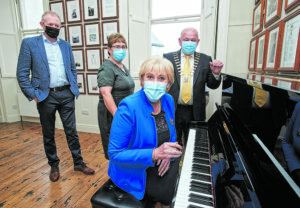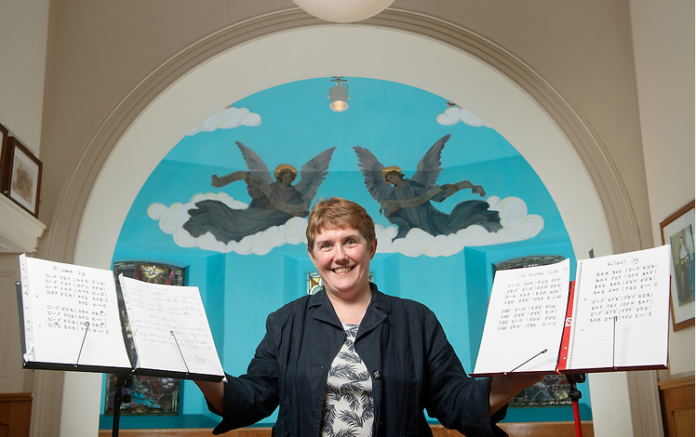CNOC na Gaoithe in Tulla was lauded by the Minister Heather Humphreys as an outstanding example of how local communities can harness support to bring old buildings back into use.
The Minister for Rural and Community Development stopped off in East Clare during her whistle-stop tour of the county last Thursday (July 29). As part of the national ‘Our Rural Future Roadshow’, the minister saw a range of projects which are being supported by funding from her department.
At the Cnoc na Gaoithe centre, where Comhaltas Ceoltóirí Éireann are redeveloping the old convent and primary school building into a cultural hub, Minister Humphreys was treated to a tour of the work to-date as well as a flavour of the rich musical traditional of the area.
“What I’ve seen here is absolutely fantastic,” Minister Humphreys told The Champion. “What strikes me most is community. Community, working with local authority, and realising their ambitions, identifying what they want to do in their own community, because nobody knows better than the people who live in it.
“Our Rural Future, which is my strategy, always been about bottom-up approach with local communities, identifying their projects, working with the local authority, making applications to my department. My job then is to support them, and to help them realise that ambition, and I’ve had an absolutely magnificent day today, finishing off at this beautiful cultural centre. The old convent building that has been converted into accommodation, and then the old school is going to be developed into an auditorium, repurposing old buildings for 21st century use.”
Following the donation of the buildings on Church Street by the Sisters of Mercy a decade ago, the convent has been redeveloped to include a small performance space, venues for classes, accommodation and a popular tearoom. Significant funding of €900,000 was granted in November 2019 under the Rural Regeneration and Development Fund (RRDF) towards the €2m regeneration project.
Construction to convert the old primary school building into a multi-purpose auditorium is now well underway, despite the challenges posed by the Covid-19.
Below: Minister Heather Humphreys sits a a piano on arrival to Cnoc na Gaoithe in Tulla, as part of the #OurRuralFuture roadshow. Looking on are senator Timmy Dooley, Brid Mc Namara, chairperson of Cnoc na Gaoithe and Cllr. PJ Ryan, Cathaoirleach Clare County Council,. Photograph by John Kelly

“We were held up greatly by the pandemic, and were shut down for five months when we could make no progress,” outlined Chairperson of the Cnoc na Gaoithe Development Committee, Breda McNamara. “But for the last couple of months, now we’re back in action and it’s great to see the progress being made. We knew from the start that this project would take ten years, and if Covid hadn’t happened we’d be on course, but we’re nearly there. We have fabulous convent building at the moment, but in terms of performance space here, it accommodates a maximum of 60 people. When we’re finished our project next door, we’ll have 170 seats in a full auditorium, which proper lighting and sound and a balcony and good dance floor. And without that funding, we couldn’t have achieved that and we’ve had great support from the community, the council and Clare Local Development Community (CLDC) – I’ll always credit Gloria Callinan with giving us the courage to believe we could do this.”
The centre, in a prime location in the heart of Tulla, is also tipped to transform the core of the town. Director of Rural Development with Clare County Council Leonard Cleary also hailed the project as an key part of wider regeneration efforts.
“This is an example of where a building could have gone into total disuse, as many old convents across the country have,” he said. “This is now a vibrant building and it’s an example of how a community like Tulla can put a flagship project forward for regeneration. But now it’s important that we move to the next phase. There are a number of vacant properties in the town of Tulla. It’s important that the local authority, the community, the business community, and government departments work together to see if we can turn around even a small number of those properties for residential use. If, down the line, there is a commercial need for them, well and good, but for now, I suppose it’s to make sure that the vacant properties are in use residentially and the people have the opportunity to have a home in the centre of the town and sustain the population which is part of the purpose of rural development.”

